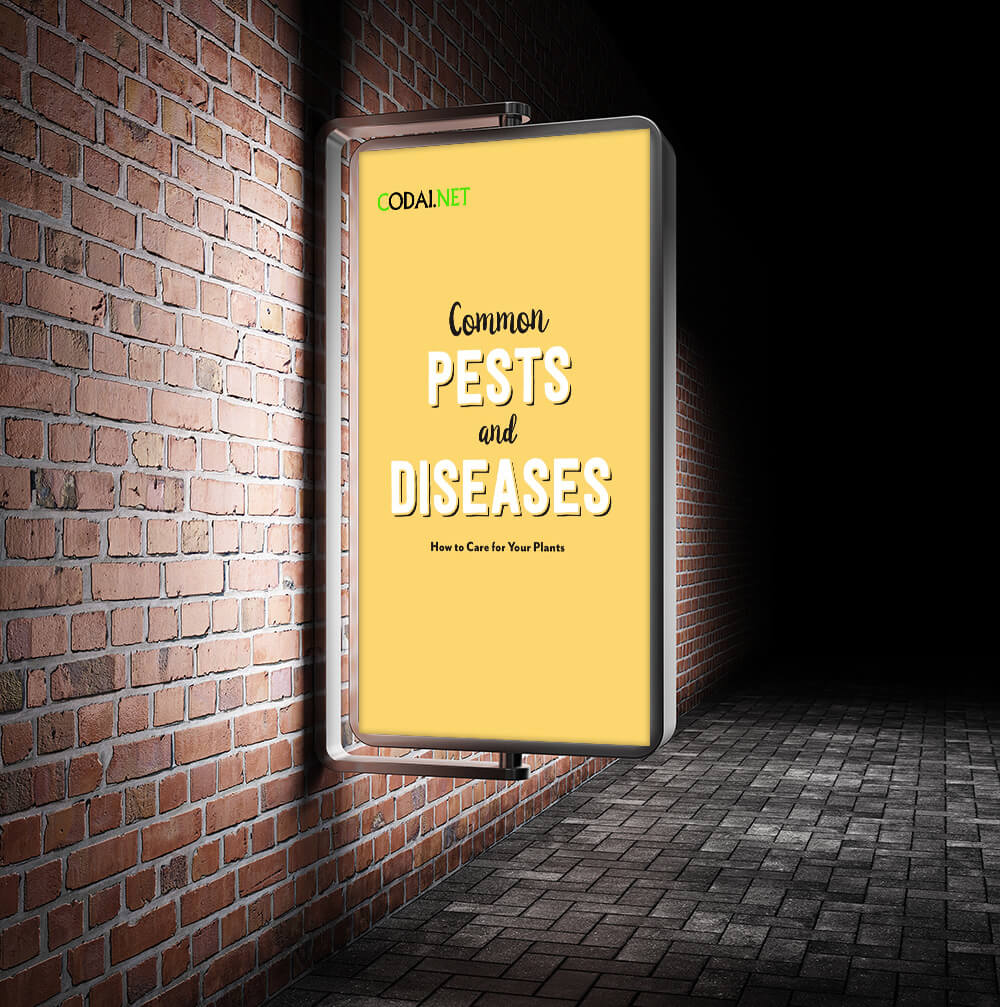Ebook Việt Hoá] Plant parenting: Easy ways to make more houseplants vegetables and flowers - LESLIE F. HALLECK
[Ebook Việt Hoá] Plant parenting – LESLIE F. HALLECK (Nhân giống cây) – TECHNIQUES FOR ELIMINATING PESTS AND DISEASE (Kỹ thuật tiêu diệt côn trùng và dịch bệnh)
- Nguồn: [Ebook Việt Hoá] Plant parenting: Easy ways to make more houseplants, vegetables, and flowers – LESLIE F. HALLECK (Nhân giống cây: Những cách dễ nhất để nhân giống cây cảnh trong nhà, rau và hoa)
- Biên tập: Dũng Cá Xinh (Tháng 08/20201)
- Dịch: Huyền Nguyễn
English
Prevention is always the best medicine. It’s good propagation policy to scout proactively for signs of diseases and insects. Never take cuttings from diseased plants and always inspect new plants you bring into your house. Consistently mind your watering habits as overwatering can quickly lead to soil-borne fungal diseases or encourage pests such as fungus gnats. Under-watering can trigger infestations from pests such as spider mites.
Clean your pots, tools, and seed trays between uses with a 10 percent hydrogen peroxide or bleach solution, or diluted vinegar. Diluted vinegar is also great for removing built-up salts from pots. If you have pruned an infected plant, sterilize your pruners in a 10 percent bleach solution before you use them on healthy plants.
Certain pests become a bigger problem when the air in your home is stagnant. Good ventilation and air movement are easy ways to reduce certain insects and diseases. If you struggle with fungus gnats or powdery mildew, you can use small fans to keep air moving around your seedlings and cuttings or place susceptible plants near air vents in your home where air may move more vigorously.
If you have a plant or plants that have become heavily infested with insects or infected with a disease, you should consider removing them completely from your growing area. Insects and diseases will potentially spread to your healthy plants if not separated. Sometimes, simply setting an infested plant outdoors on your patio or balcony for a time can naturally resolve the infestation. There are many natural predators outdoors, as well as wind, that can help cure your plant.
If you find insect eggs or disease spots on just one or two plant leaves, you can remove these leaves and dispose of them immediately. This may help stop the spread so you don’t have to sacrifice the entire plant.
TREATMENTS
If you need to treat a plant for a pest or disease, it’s wise to be mindful about the products you use, especially if you are treating edible plants, such as lettuce or tomatoes. I recommend avoiding systemic insecticides or fungicides on edible plants. Systemic products are absorbed into the plant tissue and can persist for extensive time periods. Even if you aren’t growing edibles, if you’re propagating plants to keep in your home, you probably also want to minimize chemical expo- sure. There are many organic and low-impact, topical treatment options.
Sometimes, all you need is a strong spray of water to wash off and kill certain insects, such as aphids and mites. Rinse plants under a running faucet or use a spray bottle and wipe down the leaves and stems. This method can remove a lot of the insects.
Insecticidal soaps, neem oil, and other types of horticultural oils are generally all you need to prevent or knock out pests on young seedlings or cuttings indoors. Treatments with spinosad (a natural chemical found in bacteria) are also very effective for killing chewing pests.
Thuricide (Bacillus thuringiensis or Bt) is an excel- lent natural treatment for chewing caterpillars—such as tomato hornworms or cabbage loopers—when sprayed in liquid form. Although, worm pests won’t typically be a big problem for you when starting seedlings or cuttings indoors. In its dried crumbled form, Bt can be sprinkled on top of the soil, or mixed into the soil, of indoor houseplant or seedling pots to help control fungus gnat larvae.
Sometimes, beneficial predatory insects will show up to do the job for you—even in the indoor garden. Ladybugs and ladybug larvae are aphid destroyers. When you see them on your plants, that usually means a pest insect is already there as a food source. Don’t kill them! If your plants have a fungal disease problem, look to foliar sprays with an organic fungicide, copper fungicide, neem oil, or plant wash. These are effective against diseases such as powdery mildew. Potassium bicarbonate is also a good treatment for a variety of fungal diseases.
No matter what you put on (or in) your plants, be it a treatment or fertilizer, always read the label before you use it and follow the label application instructions.
Healthy plants are better equipped to fend off insect and disease problems. Good plant care, adequate lighting, the right temperature, and even watering practices are your best defense against plant pests and diseases.
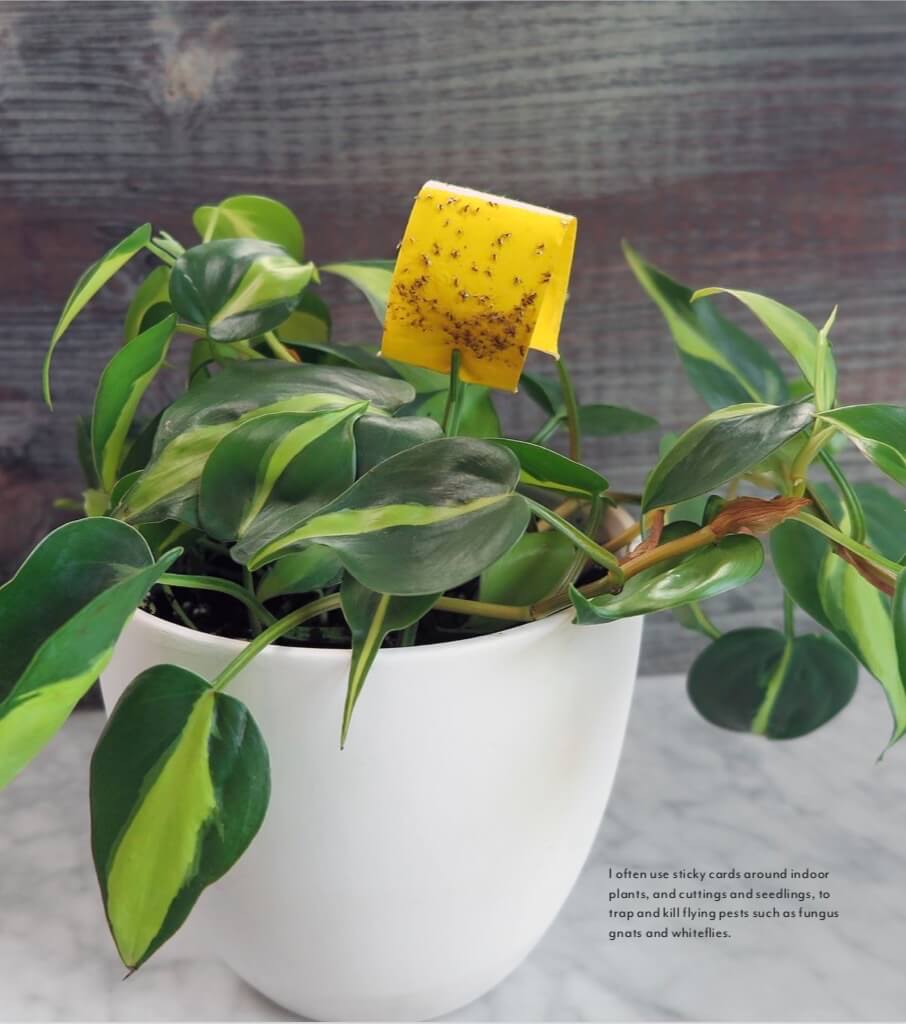
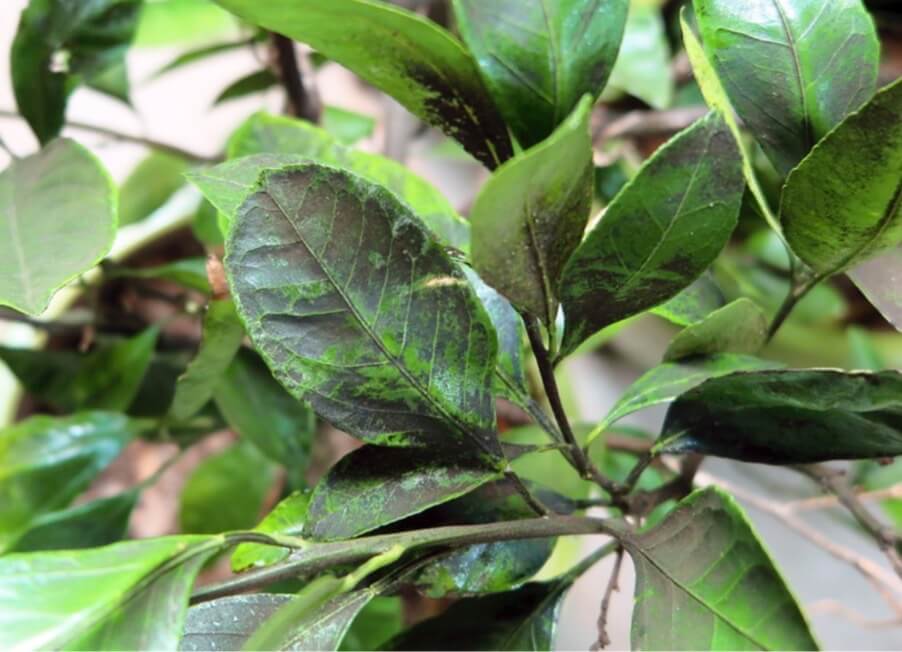
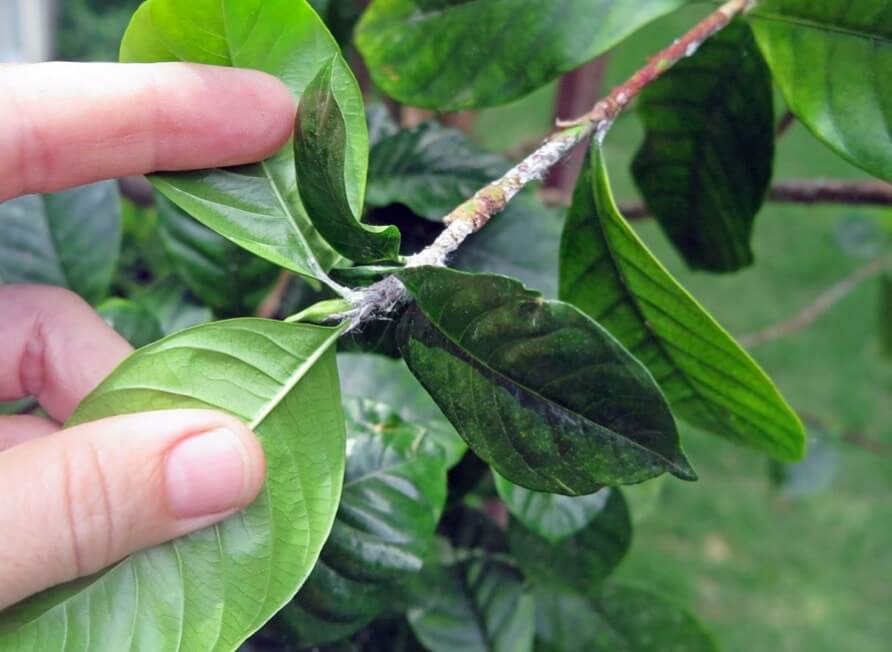
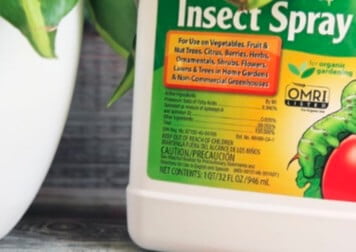
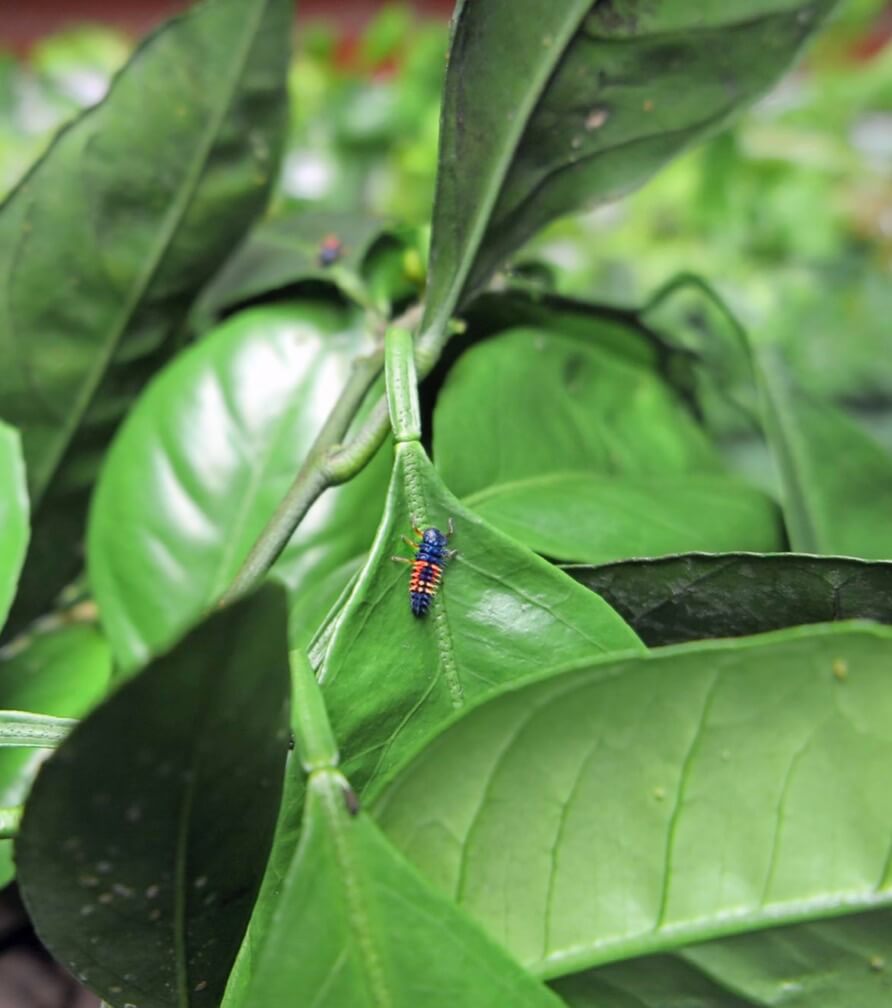
Tiếng Việt
Phòng bệnh luôn là liều thuốc tốt nhất. Cách nhận giống tốt là chủ động tìm kiếm các dấu hiệu của dịch bệnh và côn trùng. Không bao giờ giâm cành từ những cây bị bệnh và luôn kiểm tra những cây mới bạn mang vào nhà. Thường xuyên lưu ý thói quen tưới nước vì tưới quá nhiều có thể nhanh chóng dẫn đến các bệnh nấm truyền qua đất hoặc khuyến khích các loài gây hại như nấm gặm nhấm. Tưới nước quá ít có thể khuyến khích sự xâm nhập của các loài gây hại như bọ ve nhện.
Làm sạch chậu, dụng cụ và khay hạt giống giữa các lần sử dụng bằng dung dịch oxy già hoặc thuốc tẩy 10%, hoặc giấm pha loãng. Giấm pha loãng cũng rất tốt trong việc loại bỏ muối tích tụ trong chậu. Nếu bạn đã cắt tỉa cây bị nhiễm bệnh, hãy khử trùng cây cắt tỉa trong dung dịch thuốc tẩy 10% trước khi bạn sử dụng trên những cây khỏe mạnh.
Một số loài gây hại sẽ trở thành một vấn đề lớn hơn khi không khí trong nhà bị ngưng trệ. Thông gió tốt và chuyển động không khí là những cách dễ dàng để giảm bớt một số côn trùng và bệnh tật. Nếu phải vật lộn với sự gặm nhấm của nấm hoặc bệnh phấn trắng, bạn có thể sử dụng quạt nhỏ để giữ không khí lưu thông xung quanh cây con và cành giâm hoặc đặt những cây nhạy cảm gần các lỗ thông gió trong nhà để không khí thông thoáng hơn.
Nếu bạn có những cây đã bị côn trùng hoặc bị nhiễm bệnh nặng, bạn nên cân nhắc loại bỏ hoàn toàn khỏi khu vực trồng trọt. Côn trùng và bệnh tật sẽ có khả năng lây lan sang cây khỏe mạnh nếu không được tách riêng. Đôi khi, bạn chỉ cần đặt cây bị nhiễm bệnh ngoài trời, trên sân hoặc ngoài ban công trong một thời gian là có thể giải quyết được bệnh ở cây trồng một cách tự nhiên. Có rất nhiều động vật ăn thịt tự nhiên ở ngoài trời, cũng như gió, có thể giúp chữa bệnh cho cây của bạn.
Nếu bạn phát hiện thấy trứng côn trùng hoặc đốm bệnh trên một hoặc hai lá cây, bạn có thể cắt bỏ những lá này và vứt bỏ ngay lập tức. Điều này có thể giúp ngăn chặn sự lây lan, do đó bạn không cần phải bỏ toàn bộ cây.
BIỆN PHÁP ĐIỀU TRỊ
Nếu bạn cần điều trị sâu bệnh cho cây trồng, điều sáng suốt là nên lưu ý đến các sản phẩm bạn sử dụng, đặc biệt nếu bạn đang điều trị bệnh ở các loại cây ăn được, chẳng hạn như rau diếp hoặc cà chua. Tôi khuyên bạn nên tránh dùng thuốc diệt côn trùng hoặc thuốc diệt nấm có hệ thống trên cây ăn được bởi các sản phẩm sử dụng trên cả cây được hấp thụ vào mô thực vật và có thể tồn tại trong một thời gian dài. Ngay cả khi bạn không trồng cây phù du, nếu bạn đang nhân giống cây để trồng trong nhà, bạn có thể cũng cần giảm thiểu việc tiếp xúc với hóa chất. Có nhiều lựa chọn điều trị hữu cơ và ít ảnh hưởng đến chất lượng cây trồng.
Đôi khi, tất cả những gì bạn cần là một vòi nước phun mạnh để rửa sạch và tiêu diệt một số loại côn trùng, chẳng hạn như rệp và ve. Xả cây dưới vòi nước đang chảy hoặc dùng bình xịt và lau lá và thân cây. Phương pháp này có thể loại bỏ rất nhiều côn trùng.
Xà phòng diệt côn trùng, dầu neem, và các loại dầu làm vườn khác nói chung là tất cả những gì bạn cần để ngăn ngừa hoặc loại trừ sâu bệnh trên cây con hoặc cành giâm non trong nhà. Phương pháp điều trị bằng spinosad (một hóa chất tự nhiên được tìm thấy trong vi khuẩn) cũng rất hiệu quả để tiêu diệt sâu bọ nhai.
Thuốc diệt côn trùng (Bacillus thuringiensis hoặc Bt) là một phương pháp điều trị tự nhiên hiệu quả đối với sâu bướm, chẳng hạn như sâu sừng Cà Chua hoặc sâu Bắp Cải khi được phun ở dạng lỏng. Mặc dù, sâu bệnh thường không phải là vấn đề lớn đối với bạn khi bắt đầu ươm cây giống hoặc giâm cành trong nhà. Thuốc diệt côn trùng dạng khô có thể được rắc lên trên lớp đất, hoặc trộn vào đất để giúp kiểm soát ấu trùng nấm gnat.
Đôi khi, côn trùng săn mồi có lợi sẽ xuất hiện để chữa bệnh ở cây giúp bạn, ngay cả trong khu vườn trong nhà. Bọ rùa và ấu trùng bọ rùa là những côn trùng tiêu diệt rệp. Khi bạn nhìn thấy chúng trên cây, điều đó thường có nghĩa là côn trùng gây hại, nguồn thức ăn của bọ rùa đã ở đó. Đừng giết các loại côn trùng có lợi này! Nếu cây có vấn đề về nấm bệnh, hãy tìm đến các loại thuốc xịt lá có chất diệt nấm hữu cơ, thuốc diệt nấm đồng, dầu neem, hoặc thuốc rửa thực vật. Chúng có tác dụng chống lại các bệnh như bệnh phấn trắng. Potassium bicarbonate cũng là một chất điều trị tốt đối với nhiều loại bệnh do nấm gây ra.
Bất kể bạn điều trị bệnh cho cây bằng phương pháp gì, bạn sử dụng thuốc điều trị hay phân bón, hãy luôn đọc nhãn trước khi sử dụng và làm theo hướng dẫn sử dụng trên nhãn.
Cây khỏe mạnh được trang bị tốt để chống lại các vấn đề về côn trùng và bệnh tật. Chăm sóc cây tốt với đủ ánh sáng, nhiệt độ thích hợp và tưới nước đúng cách đều là cách bảo vệ tốt nhất giúp cây trồng chống lại sâu bệnh hại.





